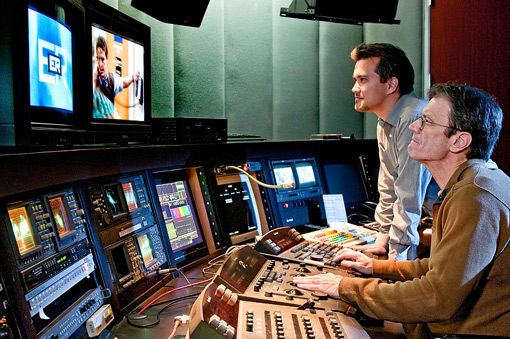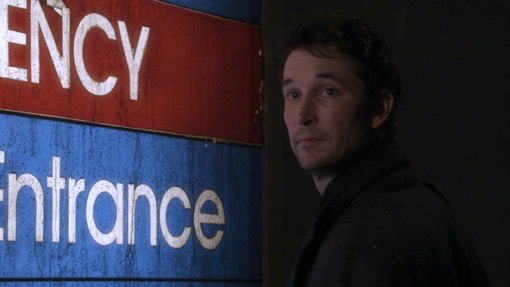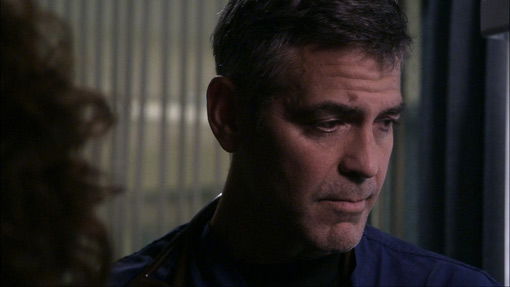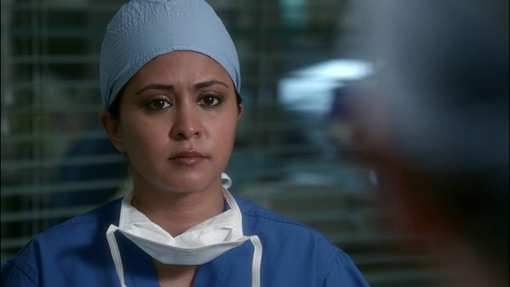How Ascent Media Companies Handled Post

All ER photography courtesy Warner Bros. Television Entertainment/J. Stenson
Then Wells went to a party and got into a conversation with director Steven Soderbergh, who had just shot the four-and-a-half-hour Che with the Red One camera. “He was raving about it, and that piqued John’s interest,” says Ismagil. When Wells shot the pilot for his upcoming series Southland, they used the Red camera to shoot a test for interiors and exteriors. “They liked the image, and they liked what they could do with it handheld, so they used it for the Southland pilot,” reports Ismagil. “They were happy with the results and with not having the added expense of film processing.” The decision was made to give it a try for the last few episodes of ER.

Early on, the ER production went to the Ascent Media Group for its Red expertise. Company 3, an Ascent Media company, had done the post for Game, an all-Red feature, in October 2007. “They sent us files every night and we turned them around to HD dailies-colored, digitized and ready for Avid,” says director of nonlinear workflow Dylan Carter. “At the time, there weren’t any tools that did exactly what we needed to do, so we built custom software for data management of the Red, used Red’s software to do the rendering, and built a render farm to deal with that. Throughout the process, we developed a close relationship with Red.”
As a result of this early Red experience, and additional work with other file-based cameras, Company 3 created a new division: DCC, or digital camera capture, focused on Red and any other file-based cameras. But it wasn’t just the Ascent Media companies’ expertise in file-based cameras that made the companies ideal for the ER workflow. “Between Encore, Company 3 and Level 3, a big chunk of Hollywood’s episodic workflow goes through us,” says Carter. “Once we rendered the Red files into something useable, we had to do all the things a lab would do, from logging to audio syncing. What they wanted from us was an Avid bin ready to edit.”

Among the ER creatives, the main concern for the Red-acquired episodes was maintaining the look of the show: gritty, urban, with heightened contrast and slightly de-saturated. Cinematographer Arthur Albert had shot 163 episodes since 2001, and Level 3 colorist Fred Eldridge had been with the show all 15 seasons. “Fred was the one constant with the show,” says Ismagil.
Eldridge notes that the very high-contrast show-with its bright high keys and rich deep blacks-lent itself well to the dynamic range of film. “Shooting digital video, you don’t usually have the same latitude,” he says. Still, he says, everyone was excited about the chance to create the show in a high-res digital format. “For the most part, people embraced [the switch to Red],” he says. “They realized this is a train leaving the station and we all need to be on board, if not to be on the cutting edge at least to be close to it.”

Shooting with the Red eliminated the mundane problems of film production-scratches, dirt-but introduced a new set of issues, including the levels recorded. “We needed to make sure the dark areas weren’t recorded too dark so we didn’t get digital noise, and that we got as much detail in the highlights as possible to get the most latitude as possible,” says Eldridge. “There were some refinements along the way but it was mostly smooth sailing.”
Finding the perfect workflow for the Red-acquired ER episodes was an evolution. After some tests, the initial plan was to use the two flavors of Avid’s high-definition codec DNxHD: the more highly compressed DNxHD 36 (36 Mb/sec) for offline editing; and DNxHD 175 for mastering. The process began with DIT-created DNxHD 36 files, with a basic LUT applied; DP Albert had a chance to look and give instructions for quick tweaks. “Every shot of the DNxHD 36 had a dailies look applied-good enough for everyone to get an idea of what the camera was doing and what it would look like eventually,” says Ismagil. “It’s the equivalent of what a one-light dailies color would look like.”
While Company 3 de-Bayered the material and created dailies, they also created a DNxHD 36 version for the Avid offline and a DNxHD 175, with log color space, for the version that would get a final color-correction. The editing team upgraded to Avid Media Composer Nitris DX editing systems, which was a smooth transition.
For the first two Red-shot episodes, the DNxHD 175 material with log color space was transferred to a hard drive, which went to Level 3 Post. “They’d dump it off onto a D-5 tape, and that’s what we’d do our tape-to-tape color correction with,” says Ismagil.

When the footage went up on the screen for the color-correction, Ismagil immediately saw a problem. “There were about 500 cuts in the show, and in about 50 shots we saw compression banding in the back of the image,” says Ismagil. “Instead of this nice falling-off of light, you see a band of a bright color of light and another band of a slightly darker color, and then another band slightly darker than that. It looked great in all our tests, but when we pushed it in color timing, this is what we got from the DNxHD 175 conform. Ninety percent of the images looked good, but too many shots exhibited compression banding, so it wasn’t good enough.”
For those two episodes, they went back to the original Red files, rendering out uncompressed HD DPX files to overcut those 50 shots. “I think Avid is the best editing system on the planet,” says Ismagil. “However, the software transcoding from the Red files to the DNxHD 175 files didn’t hold up as we needed. I’m sure they’ll have the bugs worked out soon.” [See a footnote from Avid at the bottom of this story – Ed.]
Back to the drawing board for the ER team, which had to come up with a new plan for finishing. “We got together with Level 3 and Company 3, and they came up with doing a DPX conform in the Autodesk Smoke,” Ismagil says. “We’ve eliminated the DNxHD 175 from our process. We still get dailies with the DNxHD 36. Then, when we have a locked picture, we send Company 3 a Red EDL and they use that to extract those shots, uncompressed from the original Red files as log color space and do a conform in Smoke and output a D-5. It’s given us as high-quality a picture as possible off the Red.”
In his da Vinci 2K color-correction suite, Eldridge was pleased with what he saw. “The Red does render colors a little differently,” he says. “There were some adjustments we had to make, to make sure the colors-especially the green walls in Trauma 2 and the yellow walls in Trauma 1-remained the same. We wanted to make sure the green scrubs remained green. I’m very happy with how the Red renders flesh tones. It’s a nice, natural flesh tone that didn’t take a lot of work from me to refine.” All in all, though he declares himself “biased towards film,” he says he’s been happy with the output of the Red. “I think it produces a very nice picture.”
Maintaining the ER look created one unusual situation. Ismagil reports that, for the first Red-shot episode, a 5298 film-grain look was applied using an Inferno. “But we had an incredibly clean master for the 18th episode, so we thought, let’s see what it looks like without the grain pass.” They were happy with how it looked…until they saw what the DirecTV compression did to the image. “HD made some pretty severe compression banding in some flat areas,” he says. “It didn’t have that with the 17th episode, because we degraded the image. So for episode 19, we added the grain pass back again. By degrading the image, we ended up with a cleaner broadcast image.”

Ismagil admits that the process for the last seven episodes “felt like putting a pilot together.” “You’re starting from square one,” he says. “I won’t say it was a walk in the park, but we got great support from the Ascent Media companies and New Edit, the Avid rental company that got our assistants up to speed on the Nitris system.”
For archival purposes, the ER team is creating 1080p masters on HDCAM SR. “We are archiving all our DNxHD 36 material, and that stuff looks great although it’s highly compressed,” says Ismagil. “There will also be LTO3 tape.”
With the success of ER shooting in Red, Ismagil predicts that, during the upcoming pilot season, we’ll see more TV shows shooting with the camera. And he-and the rest of the crew and the Ascent Media Group companies-are ready. “I’m confident now that we’re mastering with the best image and broadcasting the best quality,” he says. “It took a couple of steps to get there, but we have a workflow in place. I’d be very comfortable working with Red again.”
Editor’s note: F&V asked Avid for comment on the hitch in ER‘s DNxHD workflow before this story ran. At press time, there was not enough information available about which versions of Avid software were involved for the company to make a specific comment. But Michael Phillips, Avid’s solutions manager for post, spoke more generally to the evolution of Red support. “We are continuing to evolve our solutions in order to meet customers’ needs and, as a part of that, remain committed to providing customers seamless workflow solutions,” Phillips said. “Prior to our formal relationship with Red, customers were employing creative workarounds that we developed with them in order to work with their preferred camera format and favorite video-editing systems such as Media Composer. Now Avid offers full end-to-end native Red support, which eliminates many of the extra steps inherent in older workflows. The offline editing process is streamlined via Avid MetaFuze, which is a tool that automates the conversion of formats such as Red and DPX to Avid DNxHD media for HD offline workflows in Avid Media Composer and HD finishing in Symphony systems. To complete the process, the latest version of Avid DS offers a smooth offline-to-online workflow with RED file integration for online color-grading and finishing.”
Sections: Creativity Technology
Topics: Feature Project/Case study
Did you enjoy this article? Sign up to receive the StudioDaily Fix eletter containing the latest stories, including news, videos, interviews, reviews and more.